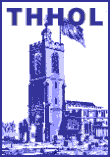THE METROPOLITAN BOROUGH OF POPLAR
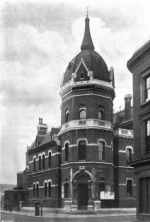 Tenth
in size and population as compared with other Metropolitan boroughs, Poplar has an area of 2,327
acres, and comprises the old parishes of All Saints, Poplar; St. Leonard, Bromley; and St. Mary,
Stratford-le-Bow. It extends from Hackney borough boundary on the north to the Thames on the
south; on the west it is bordered by the boroughs of Bethnal Green and Stepney; and on the east
the river Lea separates it from the County Borough of West Ham (Essex). There are fourteen wards
- Poplar and Bromley five each, Bow four. The rateable value is £994,526, the produce
of a penny rate £3,833. It has two Parliamentary representatives - Alderman George Lanshury,
J.P. (Bow and Bromley Division), and Alderman Samuel March, J.P. (South Poplar Division).
Tenth
in size and population as compared with other Metropolitan boroughs, Poplar has an area of 2,327
acres, and comprises the old parishes of All Saints, Poplar; St. Leonard, Bromley; and St. Mary,
Stratford-le-Bow. It extends from Hackney borough boundary on the north to the Thames on the
south; on the west it is bordered by the boroughs of Bethnal Green and Stepney; and on the east
the river Lea separates it from the County Borough of West Ham (Essex). There are fourteen wards
- Poplar and Bromley five each, Bow four. The rateable value is £994,526, the produce
of a penny rate £3,833. It has two Parliamentary representatives - Alderman George Lanshury,
J.P. (Bow and Bromley Division), and Alderman Samuel March, J.P. (South Poplar Division).
The four members of the County Council are Mr. E. Cruse and Mr. T. J. Blacketer (Bow and Bromley), and Miss A. Susan Lawrence, M.P., and Mr. George Mills (South Poplar). The Borough Council is in every sense of the word a progressive one, and a pamphlet "The Work of Six Years, 1919-1925," issued by order of the Council, shows truly wonderful results of its policy, all of which will be found set out in other pages. The policy of the Councillors has been aided by an able and energetic staff of Officers, who are as follows:-
Town Clerk - Harold Escott Dennis.
Deputy Town Clerk - William E. Nicholls.
Borough Surveyor and Engineer - Harley Heckford, M.I.C.E.
Deputy Borough Surveyor
- Daniel R. Bolt, M.B.E.
Chief Administrative Assistant - F. W. Madeley.
Borough
Electrical Engineer and Manager - J. Horace Bowden, M.I.E.E., M.I.Mech.E.
Assistant
Manager - F. Tait.
Medical Officer of Health - F. W. Alexander,
D.P.I-L.Eng.
Tuberculosis Officer - W. C. P. Smith, D.P.H. (Camb.)
Public Analyst - Albert E. Parkes, FIC., F.C.S.
Borough Treasurer and Accountant
- G. E. Martin, F.S.A.A., F.I.M.TA.
Assistant Borough Accountant - E. C.
Thomley.
Solicitor - W. H. Thompson.
Chief Librarian - Harry Rowlatt.
Deputy Librarian - R. F. Bullen.
Chief Baths Superintendent - L.
Jefferson-Hope.
The following are the names of Mayors since the institution of the Borough Council:-
| Mr. Richard Henry Green | 1900-1 |
| Rt. Hon. William Crooks, M.P. | 1901-2 |
| Mr. John Bussey, J.P. | 1902-3 |
| Sir Alfred William Yeo, J.P. | 1903-4 |
| Mr. Mark Dalton, J.P. | 1904-5 |
| Mr. Joseph Zouche Cahill, J.P. | 1905-6 |
| Mr. Fred Thorne, J.P. | 1906-7 |
| Mr. Henry Robert Barge, J.P. | 1907-8 |
| Mr. John Elias Le Manguais, J.P. | 1908-9 |
| Mr. Robert Richford Brown, J.P. | 1909-10 |
| Mr. Frederick Sedgwick | 1910-12 |
| Mr. Edwin John Aldrick | 1912-13 |
| Sir Alfred Haman Warren, OBE., J.P. | 1913-18 |
| Rev. William Henry Lax | 1918-19 |
| Alderman George Lansbury, J.P., M.P. | 1919-20 |
| Alderman Samuel March, J.P., M.P. | 1920-21 |
| Alderman Charles Edwin Summer, L.C.C. | 1921-22 |
| Alderman John Scurr, L.C.C., M.P. | 1922-23 |
| Councillor Charles W. Key | 1923-24 |
| Mr. Edgar I. Lansbury | 1924-25 |
| Councillor Joseph A. Hammond, J.P. | 1925-26 |
The Poplar Borough Council is second to none amongst the Metropolitan Boroughs for the spirited manner in which its responsibilities to the community are discharged. It has evinced a praiseworthy enterprise in seeking to deal with its own particular problems, and the fruits of its policy are evident in many directions. This spirit is reflected in the citizens a strong local patriotism exists, and the inhabitants are all keen on the welfare of their borough. "Sometimes it would appear," says the Borough Calendar, "as if it was a case of 'Poplar contra mundum,' but the people do not mind. They may divide on political and other issues; they may give and take shrewd blows; but whatever their internal differences may be, those who live in one or other of the three Parishes stand for the honour of their Borough."
For the Financial Year ending 31st March, 1926, Rates have been levied in this Borough to the amount of 23s. in the £, representing a total expenditure of £1,034,812.
The allocation of the rate among the various spending authorities is as follows:-
| s. | d. | percent. | |
|---|---|---|---|
| London County Council | 4 | 5.30 | 19.3 |
| Metropolitan Police | 1 | 1.22 | 4.8 |
| Guardians (including St. Andrew's Hospital and M.A.B.) | 10 | 3.17 | 44.6 |
| Loan Redemption and Interest in respect of Precepts, 1921-22 | 1 | 7.00 | 6.9 |
| Borough Councill | 5 | 7.31 | 24.4 |
23 |
0.00 |
100 |
The Rate of 1/7 in the £ for Loan Redemption and interest in respect of the Precepts, 1921-22 is, however, of the character of a deferred payment, and for the purposes of comparison should not be included in the rate. The correct figure is, therefore, 23/- minus 1/7, i.e., 21/5. The average annual rate during the five years ended March 31st, 1914, was 11/9 in the £, so that, in spite of the universal heavy increase in costs, the additional duties placed upon local governing bodies, and the cost of providing work or relief for an unprecedented number of unemployed, the present figure is considerably less than double the pre-war average.
The rateable value of the Borough is now £994,526, as compared with £811,148 in 1914. The increase in Rateable Value since 1st April, 1925, is £3,516. With regard to the redemption and interest charges on the special loan raised to meet the precepts for 192 1-22, it may be pointed out that (1) The relief to the rates in the current financial year resulting from the operation of the Local Authorities (Financial Provisions) Act, amounts to no less than 10/- in the £. (2) If these charges, amounting to 1/7 in the £, be deducted, there is a gain of 8/5 in the £.
The action of the Council has, therefore, resulted in easing very considerably the burdens of the inhabitants of the Borough, and for this all Poplar ratepayers should be thankful.
The Loans raised during the Mayoral Year (1925) amounted to £249,758, the allocation of the main portion being as follows: Electricity £142,181, Housing £59,990, Public Works £47,587 (including £37,468 for Unemployed Relief Works).
If the figures relating to the Electricity Under taking and Housing, and also the special loan to meet the Central Authorities' Precepts for the year 1921-22 be excluded, the indebtedness of the Borough Council has been reduced since March, 1914, from £262,831 to £257,658, a decrease of £5,173.
Strangers to the place can hardly realize the wonderful improvement that has taken place within the last generation in the Borough: for the streets, once the receptacle of every kind of garbage, are now kept scrupulously clean. The public thoroughfares are constantly swept and scoured with motor-sweepers, and over five miles of roads have been laid with asphalt.
The Council has also set a good example in fostering a love of the beautiful in Nature, and, thanks to its enterprise, over 2,000 trees have already been planted within the borough, and no less than fifty-four thorough fares are shaded in summer by their foliage. This verdure, bringing a suggestion of the country into what before was a wilderness of bricks and mortar, is an innovation that is keenly appreciated by residents, and one that never fails to appeal to the casual visitor.
The Council attaches much importance to its well stocked Libraries, and every reasonable facility is provided for the public to make the best possible use of them. There are four in the Borough, viz.
| (1) | Poplar Library | High Street | Telephone | 5112 | East |
| (2) | Cubitt Town | Strattondale St | " | 4152 | " |
| (3) | Bow Library | Roman Road | " | 5283 | " |
| (4) | Bromley Library | Brunswick Road | " | 3234 | " |
They are open daily from 9 am. till 9.30 p.m., and admission is free to all. The News and Magazine Rooms are well supplied with daily and weekly news papers, technical papers and magazines. The Lending Departments now contain over 56,000 volumes. The Bromley and Cubitt Town Libraries are conducted on the 'Open Access' system. Plans for the structural alterations necessary to permit 'open access' at the Poplar Library are now being carried out. The Reference Departments are supplied with Directories, Encyclopaedias, and other books of reference, and all books in the Lending Departments, other than works of fiction can be obtained for use in the reading rooms.
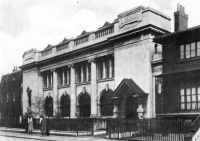 The
report for the past year (1926) fu1ly attests the excellent response of the public to the facilities
provided; 485,986 books were issued, as against 445,820 in the previous year, and the Reading
Rooms and Reference Departments were used to as great an extent as at any time during their
existence.
The
report for the past year (1926) fu1ly attests the excellent response of the public to the facilities
provided; 485,986 books were issued, as against 445,820 in the previous year, and the Reading
Rooms and Reference Departments were used to as great an extent as at any time during their
existence.
By arrangement with the Education Committee of the London County Council, and a Committee of Local Teachers, Lectures are being given to school children.
Every boy and girl of the Elementary Schools of the Borough, before leaving at the age of 14, attends a lecture by a member of the Libraries Staff, the subject being "Public Libraries, their resources, and how to make the best use of them after leaving school."
During the year also, 35 lectures were given by the Borough Librarian and the senior members of the staff, 2,104 children attending. Two similar lectures were given to children at the Poplar Training School at Hutton.
Since the commencement of the scheme, in December, 1920, two hundred and sixty meetings have been held, and they were attended by 18,973 children.
Classes from Elementary Schools attended at the Libraries, for an hour's special study, on 100 occasions, the subjects being History, Poetry, Natural History, Travel, Domestic Economy, Mythology, and London.
In connection with the Juvenile Lending Depart ment, the scheme of allowing parcels of books to outlying schools worked satisfactorily. During the year, thirteen hundred and sixty-five books were lodged at nine schools, and the teachers recorded 9,528 issues to children. Books were also lent to the Poplar Farm Colony for the use of the men at work there, and the Superintendent reported the issue of 724 volumes.
In the six years the membership has increased from 12,469 to 21,059, or nearly 67 per cent, and the number of volumes issued from 227,657 to 485,986 per annum, i.e., over 114 per cent. All this indicates a great increase in the interest shown in the libraries and the work of the Librarians.
Poplar Borough Council is proud of its Electricity Department, and has every reason to be so. There is now in course of erection a new Power Station, primarily of ten thousand kilowatts, but capable of extension to twenty thousand kilowatts capacity; this, with sixteen thousand kilowatts already installed, would provide for an ultimate capacity of thirty-six thousand kilowatts, beyond which it will, probably, not be necessary to extend in order to provide power, light, and heat for the total requirements of the Borough. The principal Electric Department and Generating Station is at Glaucus Street, Bromley; but there are showrooms and offices at Poplar, and Bow Road. Considerable progress is being made in converting gas lamps to electricity for public lighting, and soon only the latter will be used.
The maximum charge is 4 1/5d. per unit, and house holders are encouraged to avail themselves of this economical and ideal system for obtaining light and heat.
The Borough Council, in one of its Reports, says in speaking of its ideal with regard to domestic bathing facilities, " Every home should have its bathroom." Recognizing, however, that for a considerable time to come this ideal must remain unattainable in Poplar, the Council, five years ago, provided two army huts equipped with 19 slipper baths, one at Wick Lane, Old Ford, and the other at Violet Road, Bromley. The success of these was immediate, and Wick Lane is now to boast an additional twenty-four slipper baths. Last year no less than 559,637 persons availed themselves of the Borough Baths. Facilities for bathing also exist at the Public Baths in the East India Dock Road, at those in Roman Road, Bow, and the Baths in Glengall Street, Millwall.
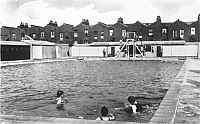 Encouraged
by the success attending these enterprises, and recognizing the value to the community of a
wider knowledge of the art of swimming, the Council next constructed, at a cost of six thousand
pounds, an Open-Air Swimming Bath at Violet Road. In the construction of this, under the direction
of the Borough Engineer, Mr. Harley Heckford, M.I.C.E., useful work was found for many of the
unemployed. Mixed bathing is permitted here. Since the opening of the above Bath another Open-Air
Swimming Bath has been constructed and made available to the public in Millwall Recreation Ground.
This latter bath is 200 feet long and 90 feet wide, and it provides ample accommodation for
200 bathers. Swimming is encouraged amongst the young, and in 1925, it is gratifying to record,
there were no fewer than 222,000 visits of children to the Baths.
Encouraged
by the success attending these enterprises, and recognizing the value to the community of a
wider knowledge of the art of swimming, the Council next constructed, at a cost of six thousand
pounds, an Open-Air Swimming Bath at Violet Road. In the construction of this, under the direction
of the Borough Engineer, Mr. Harley Heckford, M.I.C.E., useful work was found for many of the
unemployed. Mixed bathing is permitted here. Since the opening of the above Bath another Open-Air
Swimming Bath has been constructed and made available to the public in Millwall Recreation Ground.
This latter bath is 200 feet long and 90 feet wide, and it provides ample accommodation for
200 bathers. Swimming is encouraged amongst the young, and in 1925, it is gratifying to record,
there were no fewer than 222,000 visits of children to the Baths.
In a congested Borough like Poplar, where the difficulties attendant on laundry work in the home for many of the inhabitants are particularly acute, the institution of public wash-houses is a great boon.
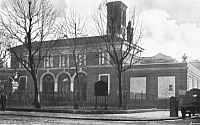 Starting
in 1851 with forty washing stalls for the use of hand-washers at the East India Dock
Road Establishment, and later (1891) at the Roman Road and the Isle of Dogs, the Council, in
spite of many obstacles, comparatively recently constructed their first mechanical wash-house,
containing six washing machines and two hydro extractors. The success of this was immediate,
and, as a result, another wash-house suitably equipped with mechanical appliances was opened
at Epson Street, a third at East India Dock Road, a fourth at Glengall Road, Isle of Dogs, and,
still more recently, the one at Wick Lane. That this public-spirited enterprise is appreciated
by the women of the borough is convincingly proved by the extraordinary numbers who avail themselves
of the facilities thus provided.
Starting
in 1851 with forty washing stalls for the use of hand-washers at the East India Dock
Road Establishment, and later (1891) at the Roman Road and the Isle of Dogs, the Council, in
spite of many obstacles, comparatively recently constructed their first mechanical wash-house,
containing six washing machines and two hydro extractors. The success of this was immediate,
and, as a result, another wash-house suitably equipped with mechanical appliances was opened
at Epson Street, a third at East India Dock Road, a fourth at Glengall Road, Isle of Dogs, and,
still more recently, the one at Wick Lane. That this public-spirited enterprise is appreciated
by the women of the borough is convincingly proved by the extraordinary numbers who avail themselves
of the facilities thus provided.
The disposal of the waste matter of the borough is a huge task, and municipalities all over the country have inspected the Corporation's Refuse Destructor which is one of remarkable efficiency.
The Borough of Poplar is conspicuous for the great attention it has devoted to the public health and for its enlightened policy in adopting the latest discoveries of science in the prevention and cure of disease. In common with other large and congested areas the Borough suffers at times from a deprivation of the activic rays of the sun, a condition of affairs caused by the smoke screen which, suspended high in the air, filters out this property of the sunlight. Observation has shown here and elsewhere that the absence of these rays has a considerable bearing upon health, particularly upon that of children. To supply the health-giving rays of light artificially, a mercurial vapour lamp was recently installed for the administration of light ray treatment at the Church Hall, Avenue Road. So gratifying were the results attending its use that an additional lamp has now been installed. Negotiations are also on foot for installing a similar lamp at the Poplar Clinic; and extensive additions will also be made to the Dispensary at Wellington Road as soon as the Ministry of Health gives its consent. Artificial sunshine is also administered at the Royal College of St. Katharine Infant Welfare Centre in Brunswick Road.
It may be asked if all this solicitude regarding the public health and expenditure of time and money upon safeguarding and improving it is justified by results. The following figures are eloquent:-
| 1919 | Death Rate (Infantile) | 83 per cent. |
| 1923 | ,, ,, ,, | 60 per cent |
Here are vital statistics which speak for themselves for the first three quarters of 1925:-
| 1st Quarter. | 2nd Quarter. | 3rd Quarter. | Average 3 Quarters. | |
| Birth Rate | 23.8 | 24.8 | 22.7 | 23.8 |
| Death Rate | 13.9 | 9.8 | 9.4 | 11.0 |
| Infantile Mortality | 77.0 | 39.0 | 67.0 | 61.0 |
The Health Cinema. It was a happy idea to utilise the lure of the cinema to inculcate a knowledge of the laws of health, and the Poplar Borough Council, through their Health Department, have not been slow to make use of this medium. There is no doubt that the motion pictures and health talks, given at the Bow Baths and Town Hall, dealing with the care and management of children and the sick, and the laws affecting the maintenance of good health, have had a very important share in the comparatively low rate of mortality in the Borough.
Recognising the need for unremitting vigilance in a borough so densely populated, the Poplar Borough Council has made hygiene and sanative provisions its special care. Particular attention has been given to Tuberculosis, and the Council has been repaid by seeing a steady diminution in the number of sufferers from this disease. The preseiit Voluntary Tuberculosis Dis pensary was taken over in 1920; the staff was increased and the Headquarters removed to 1, Wellington Road, Bow Road, E.3, where sufferers from all parts of the Borough receive prompt attention under the supervision of an expert staff. That the work is bearing fruit is demonstrated by. the fact that since the staff of the Tuberculosis Health Visitors has been increased, the number of notifications of the disease has been more than halved.
The Maternity and Child Welfare Clinic is doing wonderful work, both educationally and practi cally. To cope with the demands upon its services it has been found necessary to provide additional accom modation. The attendance of mothers at this clinic has now reached over forty thousand per annum, and each year sees a great increase.
The Borough had necessarily to face the burning question of the post-war house shortage. Confronted with many almost insuperable difficulties, but knowing the urgency of the matter, and anxious to relieve the appalling overcrowding, the Mayor, Councillor Joseph Arthur Hammond, J.P., in co-operation with the Works and Special Housing Committees, and with the invaluable services of the Officers of the Council, pluckily faced the situation. Splendid results have been achieved, and while the efforts made have not yet been completely successful in getting rid of overcrowding, great progress has been achieved towards this ideal. The Kingfield Street, Billson Street and Parsonage Street Housing Schemes were completed last year, as also was the Bow Road Scheme, thus providing accommodation for nearly one hundred families. In Lower North Street, under the Poplar Improvement Scheme, including Lower North Street and Sophia Street, thirty-six flats have been provided. A scheme of building seventy-two houses between Manchester Road and East Ferry Road is rapidly approaching completion. The Ministry of Health has further approved the building of ninety-six houses and flats in Glengall Road, Millwall. Twelve condemned houses in St. Leonards Street and four in Gale Street, Bromley, will ultimately give way to twenty-two flats to be erected forthwith. Twenty-one displaced tenants have been provided with accommodation in High Street, Montague Place and Upper North Street. In short, thanks to the well-nigh superhuman efforts of the Council, no less than three hundred houses have already been constructed under the Housing Acts, and it is anticipated that two hundred more will be erected this year (1926). Such a record, in a densely populated district, is one of which any borough might well be proud. By nomination of the Borough Council, a further eighty families have been accommodated on the L.C.C. Estates. Despite the strenuous efforts to avoid overcrowding, the difficulty of providing alternative accommodation for families displaced is tremendous.
As the Council points out in a little brochure entitled "The Work of Six Years," the provision of new houses in Poplar is not an easy task, for there is little vacant land that can be used for the purpose. Moreover, the Council prudently avoid rent-racking; including rates and taxes, the houses are let at rentals ranging from 12/6 to 21/- per week.
An efficient staff of Sanitary Inspectors is employed by the Council, who keenly appreciate the situation in dealing with insanitary property, and no less than 2,954 Statutory Notices were served on delinquents during the last year; such efforts are all to the public good, and improved health must inevitably result from these exertions.
Much useful work is accomplished by the Guardians of the Poor, whose offices are at Upper North Street: they control the Institution, in the High Street; the Farm Colony, at Laindon; St. Andrew's Hospital, Devons Road; the Hutton P. L. Schools, Shenfield; and the Langley House Receiving Home for Children, East India Dock Road. Many thousands are thus under the care of this important body; the Board consists of twenty-four members; the chairman is Councillor C. W. Key ; the clerk Mr. C. Butler.
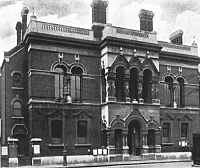 "It
is characteristic of Dock areas," to quote a Borough pamphlet, "that they are the first to suffer
and the last to recover from a trade slump." But everything that could be done to minimise such
suffering during the post-war trade depression has been done by the Poplar Borough Council.
Five thousand men, at a cost approximating to two hundred thousand pounds, have been given temporary
employment in road paving, tree planting, constructing swimming baths, and in carrying out other
useful public work within the Borough. The Guardians of the Poor during this trying period have
necessarily been confronted with a tremendous task, which has presented problems of an unusual
character.
"It
is characteristic of Dock areas," to quote a Borough pamphlet, "that they are the first to suffer
and the last to recover from a trade slump." But everything that could be done to minimise such
suffering during the post-war trade depression has been done by the Poplar Borough Council.
Five thousand men, at a cost approximating to two hundred thousand pounds, have been given temporary
employment in road paving, tree planting, constructing swimming baths, and in carrying out other
useful public work within the Borough. The Guardians of the Poor during this trying period have
necessarily been confronted with a tremendous task, which has presented problems of an unusual
character.
THE BOROUGH OF POPLAR CHILDREN'S CARNIVAL FUND.
A noteworthy feature of the Borough of Poplar is the interest displayed in the children by the elected representatives of the people and by the inhabitants generally. The Children's Carnival Fund Committee, of which the Mayor is Chairman, and Mr. George W. Paton, Managing Director of Messrs. Bryant & May Ltd., is Patron, entertain annually, on New Year's Day, all the children of the Borough between 6 and 14 years, totalling some 30,000.
These are entertained in the various Entertainment and other Halls of the Borough, kindly placed at the disposal of the Committee, and all the money needed is provided by voluntary contributions. The children thus have a memorable day with which to start the year.
Benevolence is never idle in the East End, and many bequests have been made, other than those governed by the Ecclesiastical Commissioners; thus, in connection with All Saints', Poplar, there is the Prisca Coborn Charities for the relief of poor seamen's widows; no person receives more than fifty shillings in one year: the income is £23 13s. 8d. Nominated by the Councillors representing the wards of the former parishes, certain members act in place of the Overseers in the administration of the Parochial Charities (apart from Ecclesiastical charities) for a period of four years.
The Poplar Benevolent and Accident Relief Society, founded in 1846, is one of the oldest and worthiest charities in the East End. Its offices are at the Town Hall, Poplar, and it does an incalculable amount of good in the Borough.
LONDON COUNTY COUNCIL UNDERTAKINGS IN THE BOROUGH.
The L.C.C. Ambulance Station and the L.C.C. Woolmore Street Schools are in the vicinity of the High Street; in Manisty Street are two blocks of L.C.C. flats, known as Toronto and Montreal Buildings. Facing Preston Road are more L.C.C. flats named after the Canadian Provinces and cities of Winnipeg, Quebec, Ontario, and Ottawa; these accommodate hundreds of families and form some barrier to overcrowding which the Council is working so indefatigably to eliminate.
An eighteenth-century work gives the area of Poplar as 465 acres and 218 acres of arable land. The latter has long since been built over.
There were 25 streets in the rate-book of the Hamlet of Poplar and Blackwall in 1810; increased to 58 in 1818 for the newly constituted Parish of All Saints', Poplar. At the present time the number, including the old parishes of Bromley St. Leonard and St. Mary, Bow, amounts to several hundreds.
Roman Evidences. The London and Middlesex Archaeological Society in 1856 pronounced certain coffins discovered by excavators within the boundaries of the Borough to be of Roman origin; and it was inferred that there had been, during the Latin occupation, a Roman Cemetery in the neighbourhood.
OLD-TIME DISTINGUISHED RESIDENTS.
Although the Borough may not be rich in associations with historical celebrities, there are not wanting suggestions of a storied past, in the old buildings, courts, and alleys that still exist. Tradition says that Sir Walter Raleigh once resided in the neighbourhood; that Vice-Admiral Sir Thomas Spert, Controller of the Navy to the King and first Master of the Corporation of Trinity House, lived here; and that Sebastian Cabot, the great navigator, was another one-time distinguished resident.
Until the early part of last century Poplar's ancient Manor House was still existing on the south side of East India Dock Road. It was a timber-built dwelling, at one time owned by Sir William Dethick, Garter-King-at-Arms in the reign of Queen Elizabeth. The Lord of the Manor in the time of Edward III was Sir John de Pulteney, whose London residence was Cold Harbour, in Upper Thames Street; but there is no record of his having lived at the old Manor House.
